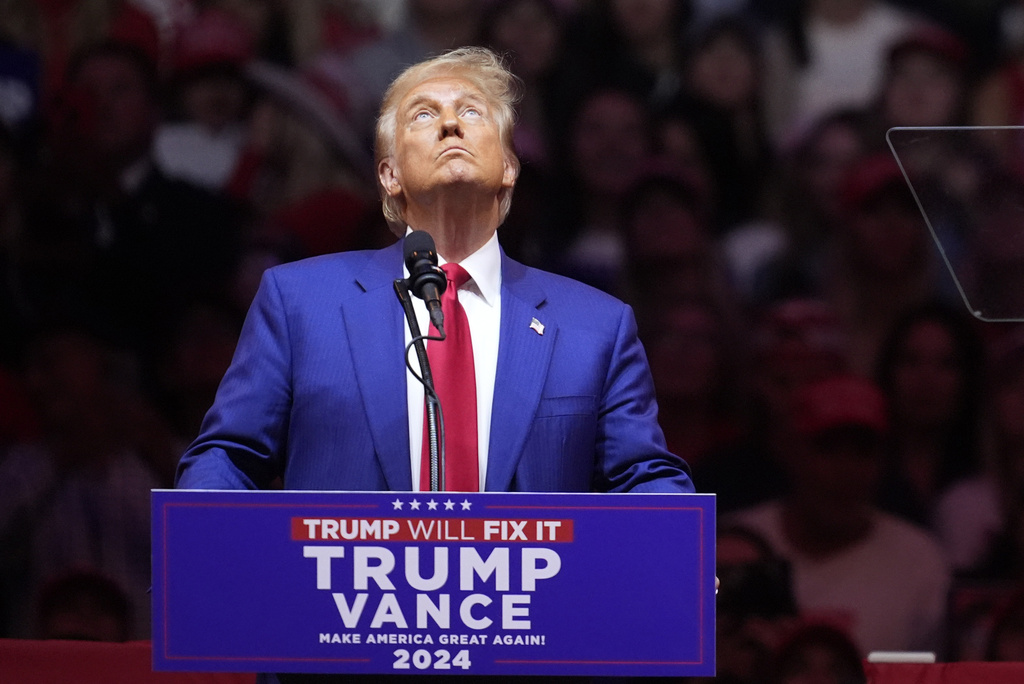Trump’s 2024 Victory: A Shift in U.S. Political Landscape \ Newslooks \ Washington DC \ Mary Sidiqi \ Evening Edition \ Donald Trump’s 2024 presidential victory marks a pivotal moment for American politics, reflecting deep national divides and significant voter discontent. His win, backed by a GOP-controlled Senate, sets the stage for potential major policy shifts and challenges to democratic norms, driven by themes of economic grievances and calls for upheaval.

Analysis of Trump’s 2024 Victory Quick Looks
- Historical Return: Trump became only the second president to win non-consecutive terms.
- Voter Discontent: Economic concerns, perceived government failures, and calls for drastic change fueled his victory.
- Campaign Tone: Trump’s dark, aggressive rhetoric resonated with many seeking disruption over stability.
- Democratic Setbacks: Kamala Harris’s campaign was unable to match Trump’s momentum despite widespread concerns about democracy.
- Impact on Governance: Promises of aggressive reforms could reshape U.S. political and social structures.
Deep Look
A Divided Reflection of America
Presidential elections act as mirrors, reflecting the nation’s mood, priorities, and tensions. This time, the reflection revealed a country grappling with deep divisions. Trump’s campaign was marked by fierce rhetoric, branding the nation as “garbage” and his opponent, Vice President Kamala Harris, as unfit with labels such as “communist” and “stupid.” Despite his confrontational tone, or perhaps because of it, voters rallied to him in significant numbers, drawn by his message of disruption and change.
AP VoteCast’s comprehensive survey of more than 120,000 voters found that concerns about democracy played a complex role in Trump’s victory. While many voters worried about potential authoritarianism, a notable portion still chose him, prioritizing economic security, immigration policies, and a desire for upheaval in government operations over fears of autocracy.
The Appeal of Disruption
In a nod to this, about 4 in 10 Trump voters expressed a desire for complete upheaval in how the country is run. This desire for radical change was a driving force behind Trump’s ability to capture significant support across key battleground states, outperforming expectations among various voter demographics, including younger and middle-income voters.
Harris and the Democratic Challenges
Harris, despite strong campaigning and efforts to build on President Biden’s achievements, struggled to expand her coalition. The Democrats’ inability to connect more deeply with working-class and economically anxious voters contributed to her defeat.
Promises of Radical Change
Trump’s campaign, characterized by promises of sweeping changes, raised alarms among political analysts and constitutional scholars. He openly pledged to use presidential power in unprecedented ways, such as pursuing personal political enemies through the justice system and potentially using military force against perceived domestic threats. Such promises suggested a potential shift away from the traditional separation of political and judicial powers.
Eric Dezenhall, a political analyst and crisis management expert, noted Trump’s rhetoric often blends hyperbole with serious intent. “There is a theme of vengeance,” Dezenhall stated, pointing to Trump’s consistent pattern of framing himself as a defender against an entrenched “deep state” that includes military and civil service figures who resisted him during his first term.
A Republican Mandate and Guardrails
However, limits remain. The Supreme Court, with its conservative majority, may play a pivotal role in determining how far presidential power can extend, particularly if Trump’s actions provoke constitutional challenges. The potential for the House to check presidential authority depends on the yet-undetermined final control of the chamber.
Voter Trends and Future Implications
The election results showed notable shifts among voters, particularly under-30 demographics, with close to half supporting Trump—an improvement over his 2020 performance. This group, marked by economic anxiety and a sense that the nation was on the wrong track, aligned with Trump’s promises of significant change.
Bernie Sanders, an independent senator from Vermont, provided a critical post-election analysis, asserting that the Democratic Party’s disconnect with working-class voters led to its decline. “A Democratic Party which has abandoned working people would find that the working class has abandoned them,” he remarked, underscoring the socioeconomic divisions exposed by the election.






